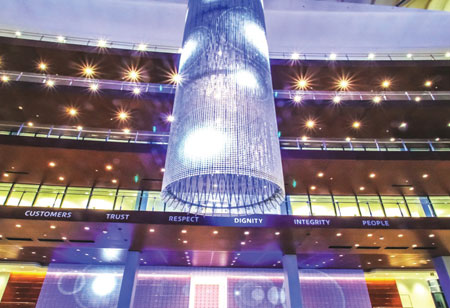
A Paradigm Shift In Power Sector


Debasish Banerji, Director - Sales & Service & Power Quality Division, India, Eaton, 0
A recent report by the International Energy Agency (IEA) divulges that the growth of renewable energy capacity will accelerate in the next five years and account for almost 95 percent of the increase in global power capacity through 2026. The report also says that India will add more than 120 gigawatts (GW) of renewable capacity over the next five years, increasing 86 percent of existing capacity, making it the third fastest-growing market after China and the US. While India takes long strides towards energy transition with ambitious targets and plans, the role of power distribution companies will be crucial.
To know more about the latest news from the industry, CEO Insights engages in an exclusive interaction with Debasish Banerji, Director- Sales & Service, and Power Quality Division, India, Eaton. A result-oriented leader and industry veteran boasting 30 decades of professional experience, Debasish joined Eaton last year to lead the company's Power Quality (UPS) Sales & Services business in India.
The energy market landscape is in transition. Major players are also going through the transition. Could you tell us about its impacts contributing to the Indian economy?
The power generation sector in India is transforming with the growing prominence of Renewable Energy (RE). While thermal power remains the mainstay, non-conventional sources such as wind, solar, and agricultural and domestic waste increase their share in the overall power generation pie.

India's installed renewable energy capacity has increased 286 percent in the last 7.5 years. It stands at more than 151.4 Giga Watts (including large Hydro), which is about 39 percent of the country's total capacity (as of 31st December 2021). By 2040, renewable energy sources could generate around 49 percent of the total electricity, as more efficient batteries will be used to store electricity. It will further cut the solar energy cost by 66 percent compared to the current cost. Power generation from solar and wind projects is likely to be cost-competitive relative to thermal power generation in India in 2025-30.
Indian economy would gain more strength and grow faster with abundant energy availability from varied renewable sources. Both goods and services sectors in the Indian economy would prosper and contribute more to the country's GDP in the coming years.
Could you give a brief account of the latest technologies that support bi-directional power generation, storage, and energy management, to meet demand growth and balance grid volatility?
The significant advantage of a more advanced network with the bidirectional flow is utilities can avoid substantial capital investments that they would otherwise have to make. Instead of investing in large power plants or peaker plants, they can tap into the capacity and the capability of distributed generation resources or energy storage resources owned by customers. And in fact, that the utility avoids that cost means they can pass some of that savings on to commercial, residential, or industrial customers looking for ways to offset the investment they need to make to put renewables on their site.
Eaton is an intelligent power management company promoting the 'Everything as a Grid' concept. It is our way of saying that many different types of facilities or players will play a role in generating, balancing, storing, and distributing electricity, all activities are historically done by utilities.
We're moving to a world where something as small as your home might generate electricity, with solar panels stored in a battery storage system. We can utilize software that decides when to use the electricity from solar, when to charge the batteries, when to release the charge from the batteries, and optimize that whole process to determine when to sell things back to the grid. That type of balancing at any size is really what we mean when we say 'Everything as a Grid'. Nothing much is different for more extensive facilities like commercial buildings, data centers, or industrial sites. For example, in a data center, you'll have to coordinate multiple sources of electricity supply, from the diesel generators there to the onsite solar to the utility feed. And they then use the batteries connected to their UPS systems to provide a variety of services back to the grid.
What is your view on decarbonizing the marine and energy markets, innovative and efficient solutions to play a central role, and positive contribution towards a low carbon future?
Decarbonizing the power sector means reducing the emissions per unit of electricity generated (often given in grams of carbon dioxide per kilowatt-hour). Around the world, countries need to decarbonize their power sectors as a crucial part of meeting the emissions reduction targets contained in their nationally determined contributions to the Paris Agreement on climate change.
So far, India is doing well and is one of the few countries on a path to fulfilling its commitments for its nationally determined contributions (NDC) for 2030. However, the road ahead on the energy transition will become more challenging. Therefore, it is important to develop a coordinated approach to both goal-setting and the associated long-term planning that is effective and economically sound so that the energy transition is as smooth as possible and is done at the lowest cost.
The emissions from electricity production, industrial and construction activities and transportation dominate India's energy sector emissions. And while electricity production will drive significant carbon emissions reduction, the "harder-to-abate" transportation and industry sectors will hold the key to India's net zero goal, and more so the one billion tons reduction by 2030 goal.
India's decarbonization action so far has had a sharp focus on electrification (a high share of renewables) and energy efficiency. This, however, would not be enough to decarbonize manufacturing sectors like iron and steel. Deep decarbonization of these and other industries like ammonia, methanol, and refineries will require green hydrogen interventions. Declining costs of electrolyzers and low-carbon/renewable electricity provide India with this unique leapfrog opportunity. Green hydrogen, with the potential for demand to grow five-fold by 2050, can reduce nearly 40 percent of emissions from sectors like iron and steel(i.e.cumulative emissions reduction of nearly 1.5 billion tons by 2050)and will be critical for the deep decarbonization of the Indian economy.

The expected doubling of India's urban population in the next three decades, and the increasing heat stress in most regions in the country, will increase cooling and thermal comfort needs. India will need an ambitious net-zero emissions building roadmap and target all new construction to be netzero, starting in 2031. Additionally, passive-cooling solutions and hyper-efficient cooling technologies need to be rapidly scaled to achieve annual emissions savings to the tune of 250 million tons of CO2.
Could you brief us about the Flexible energy systems that will power the future?
The flexible energy system is a new topic which means modifying generation and/or consumption patterns in reaction to an external signal (such as a change in price) to provide a service within the energy system'. For example, a large-scale battery could charge up when there is an additional generation in a flexible system and discharge this energy onto the grid when demand is highest. At the other end of the spectrum, a consumer might use an app to monitor the price of electricity and choose to schedule their home appliance to run a cycle midmorning, rather than running it after work when demand and electricity prices are at their highest. Among other benefits, flexibility moderates demand on the energy system, reducing the generation capacity required to meet demand, and avoiding building excess generation which sits idle in the backup for those times when our electricity demand is at its greatest.
Let me share an example of a 'flexible energy system' that Eaton offers to its Data Center customers Energy Aware UPS. A UPS system acts as a power backup if there is a power cut. UPS safeguards data centers against potentially damaging power anomalies to ensure business continuity during an unexpected power outage. Most large-scale data centers have already deployed substantial battery banks to provide adequate backup in a blackout. Yet these batteries sit unused most of the time because power outages occur infrequently. Operators in today's hyper-scale, multi-tenant, and other large data centers can leverage this underutilized asset by turning their UPS into a profit center and supporting the grid as a distributed energy resource (DER). The adoption of lithium-ion batteries, which offer a longer lifespan and eight times the cycle rate of traditional VRLA batteries, has created the potential for this evolution of the conventional UPS.
Usually, the data center maintains control of its energy (choosing how much capacity to offer and when). It can also convert the traditional power backup into an energy storage device. If your utility rate structure includes high demand charges, UPS batteries can be called on to curtail peak power draw from the utility, reducing costly demand charges.
The implications of the Energy Aware UPS are significant, both for the grid and for data center operators. The technology can be utilized to lower demand and peak time charges, as well as contribute to clean energy goals. Customers can use an existing asset to create a new revenue stream and lower energy costs while still providing a vital backup solution.
Could you tell us about the major steps that are technically helping to meet the electrification goals of the country?
India's electricity demand is set to increase much more rapidly than its overall energy demand. But a defining feature of the outlook is a sharp rise in variability– both in electricity output, from solar PV and wind, and in daily consumption. On the supply side, output from renewables in some Indian states is set to exceed demand regularly (typically around the middle of the day) before 2030. On the demand side, the key contributor to variability comes from rapid growth in ownership of air-conditioning units. Energy efficiency measures targeting both cooling appliances and buildings avoid around a quarter of the potential growth in consumption in the Stated Policies Scenario (STEPS), but electricity demand for cooling still increases six-fold by 2040, creating a major early evening peak in electricity use.
Energy demand for road transport in the STEPS is projected to more than double over the next two decades, although this growth is cut dramatically in the Sustainable Development Scenario. Over half of the growth in STEPS is fueled by diesel-based freight transport. An extra 25 million trucks are traveling on India's roads by 2040 as road freight activity triples, and a total of 300 million vehicles of all types will be added to India's fleet between now and then. Transport has been the fastest-growing end-use sector in recent years, and India is set for a huge expansion of transportation infrastructure from highways, railways and metro lines to airports and ports.
As the world seeks ways to accelerate the pace of transformation in the energy sector, India is uniquely positioned to pioneer a new model for low-carbon, inclusive growth. India is already a global leader in solar power and solar combined with batteries will play a massive part in India's energy future. But India will need a whole host of technologies and policies to chart this new path. As new industrial sectors emerge and clean energy jobs grow, India will also need to ensure that no one is left behind, including in those regions that are heavily dependent on coal today.
India's decarbonization action so far has had a sharp focus on electrification (a high share of renewables) and energy efficiency. This, however, would not be enough to decarbonize manufacturing sectors like iron and steel. Deep decarbonization of these and other industries like ammonia, methanol, and refineries will require green hydrogen interventions. Declining costs of electrolyzers and low-carbon/renewable electricity provide India with this unique leapfrog opportunity. Green hydrogen, with the potential for demand to grow five-fold by 2050, can reduce nearly 40 percent of emissions from sectors like iron and steel(i.e.cumulative emissions reduction of nearly 1.5 billion tons by 2050)and will be critical for the deep decarbonization of the Indian economy.

The expected doubling of India's urban population in the next three decades, and the increasing heat stress in most regions in the country, will increase cooling and thermal comfort needs. India will need an ambitious net-zero emissions building roadmap and target all new construction to be netzero, starting in 2031. Additionally, passive-cooling solutions and hyper-efficient cooling technologies need to be rapidly scaled to achieve annual emissions savings to the tune of 250 million tons of CO2.
Could you brief us about the Flexible energy systems that will power the future?
The flexible energy system is a new topic which means modifying generation and/or consumption patterns in reaction to an external signal (such as a change in price) to provide a service within the energy system'. For example, a large-scale battery could charge up when there is an additional generation in a flexible system and discharge this energy onto the grid when demand is highest. At the other end of the spectrum, a consumer might use an app to monitor the price of electricity and choose to schedule their home appliance to run a cycle midmorning, rather than running it after work when demand and electricity prices are at their highest. Among other benefits, flexibility moderates demand on the energy system, reducing the generation capacity required to meet demand, and avoiding building excess generation which sits idle in the backup for those times when our electricity demand is at its greatest.
Let me share an example of a 'flexible energy system' that Eaton offers to its Data Center customers Energy Aware UPS. A UPS system acts as a power backup if there is a power cut. UPS safeguards data centers against potentially damaging power anomalies to ensure business continuity during an unexpected power outage. Most large-scale data centers have already deployed substantial battery banks to provide adequate backup in a blackout. Yet these batteries sit unused most of the time because power outages occur infrequently. Operators in today's hyper-scale, multi-tenant, and other large data centers can leverage this underutilized asset by turning their UPS into a profit center and supporting the grid as a distributed energy resource (DER). The adoption of lithium-ion batteries, which offer a longer lifespan and eight times the cycle rate of traditional VRLA batteries, has created the potential for this evolution of the conventional UPS.
Usually, the data center maintains control of its energy (choosing how much capacity to offer and when). It can also convert the traditional power backup into an energy storage device. If your utility rate structure includes high demand charges, UPS batteries can be called on to curtail peak power draw from the utility, reducing costly demand charges.
The implications of the Energy Aware UPS are significant, both for the grid and for data center operators. The technology can be utilized to lower demand and peak time charges, as well as contribute to clean energy goals. Customers can use an existing asset to create a new revenue stream and lower energy costs while still providing a vital backup solution.
Could you tell us about the major steps that are technically helping to meet the electrification goals of the country?
India's electricity demand is set to increase much more rapidly than its overall energy demand. But a defining feature of the outlook is a sharp rise in variability– both in electricity output, from solar PV and wind, and in daily consumption. On the supply side, output from renewables in some Indian states is set to exceed demand regularly (typically around the middle of the day) before 2030. On the demand side, the key contributor to variability comes from rapid growth in ownership of air-conditioning units. Energy efficiency measures targeting both cooling appliances and buildings avoid around a quarter of the potential growth in consumption in the Stated Policies Scenario (STEPS), but electricity demand for cooling still increases six-fold by 2040, creating a major early evening peak in electricity use.
Energy demand for road transport in the STEPS is projected to more than double over the next two decades, although this growth is cut dramatically in the Sustainable Development Scenario. Over half of the growth in STEPS is fueled by diesel-based freight transport. An extra 25 million trucks are traveling on India's roads by 2040 as road freight activity triples, and a total of 300 million vehicles of all types will be added to India's fleet between now and then. Transport has been the fastest-growing end-use sector in recent years, and India is set for a huge expansion of transportation infrastructure from highways, railways and metro lines to airports and ports.
As the world seeks ways to accelerate the pace of transformation in the energy sector, India is uniquely positioned to pioneer a new model for low-carbon, inclusive growth. India is already a global leader in solar power and solar combined with batteries will play a massive part in India's energy future. But India will need a whole host of technologies and policies to chart this new path. As new industrial sectors emerge and clean energy jobs grow, India will also need to ensure that no one is left behind, including in those regions that are heavily dependent on coal today.